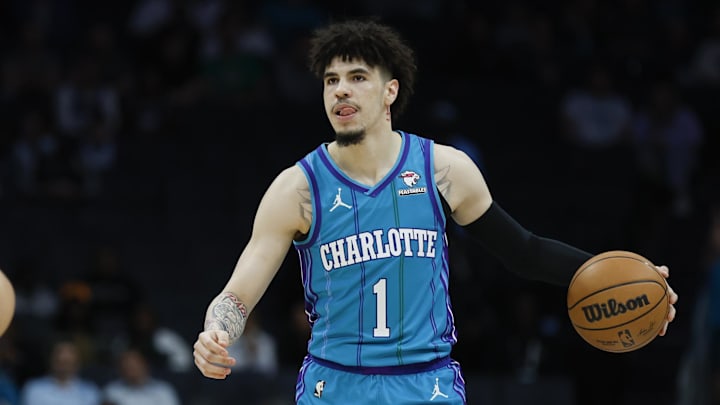There’s no ifs, ands or buts about it: LaMelo Ball is the Charlotte Hornets’ most important piece to their long-term future success. Ball’s elite offensive creation ability not only as a three-level scorer but wizard-like skills as a primary playmaker boost his profile to showcase immense long-term potential. Even with high-usage guards like Terry Rozier around throughout the duration of his rookie contract, Ball still averaged 20.0 points and 7.4 assists.
However, there is merit to the other side of the argument saying Ball has simply been unreliable for Charlotte since his first All-Star appearance in 2021-22. The one year Ball was healthy, participating in 72 games for the Hornets, he was a no-question top-level guard in the Eastern Conference. Since then, Ball has failed to even play at least half of a season, 58 of Charlotte’s possible 164 games.
That’s right, Ball has only played in 35 percent of the Hornets’ games over the last two seasons, but, when he’s on the floor, that tantalizing upside always shows through. And the way Ball has been hurt truly is on freak accidents involving his ankles.
A good comparison for Ball here is Stephen Curry, who also struggled early on his career with ankle injuries before embracing wearing braces. For Ball, it’s well past that time.
As the Hornets’ face of the franchise, the first rookie-scale max contract in franchise history as well, Ball’s availability must be fixed immediately.
Questions about Ball’s injury history are robust, but what about an intriguing on-court angle that hasn’t been talked about enough in Charlotte?
Should the Hornets explore playing LaMelo more off-ball next season?
When diving into the shooting numbers for Ball, it certainly brings up a counter-argument for why the Hornets might explore adding another playmaking creator at No. 6 overall in the 2024 NBA Draft.
Ball’s shot diet has always been one that’s a bit erratic. When Ball is feeling it, he’s the type to chuck a heat check 35-footer to see if it goes in. It’s all apart of the free-flowing, fast-paced nature a team led by Ball will possess.
The next step in the evolution of Ball on the offensive end is developing a more efficient attack. The truly elite high-usage on-ball creators typically carry a true shooting percentage above the 60 percent mark. For Ball, his career average is a measly 54.9 percent, which jumped to a career-best in 2022-23 before his season-ending injury at 56.1 TS%.
Taking around 45 percent of his shot attempts from beyond the arc since being drafted No. 3 overall in 2020, there’s a simple fix to Ball’s profile that could skyrocket his overall arsenal into that elite tier.
It’s well past due for Ball to embrace playing more at shooting guard alongside another playmaking-type. And with new head coach Charles Lee in place, who has put an emphasis in player development on analytics-based strategies, Ball will realize the potential oozing out of this switch.
Since entering the Association, Ball’s three-point shooting splits between catch-and-shoot and spot-up opportunities don’t correlate:
2020-21 = 39.3 3PT% on C&S; 32.1% on pull-ups
2021-22 = 42.5 3PT% on C&S; 34.1% on pull-ups
2022-23 = 40.4 3PT% on C&S; 34.8% on pull-ups
2023-24 = 35.7% on C&S; 34.7% on pull-ups
With the mileage of data we have on Ball’s shooting thus far, it’s fair to assume his 35.7 percent mark on catch-and-shoot this past season was the outlier. Throughout his career, Ball is a plus-40 percent from deep (40.7%) when he’s able to aim and fire off-ball. When he’s already in possession of the basketball, it drops to a career total 33.9% for pull-up situations. Of course the latter is a higher degree of difficulty to master, but it’s a thought-provoking idea when imagining how the Hornets can build out their roster around him.
With this simple correction, even slight percentage points difference in overall shot changes from three-point range, Ball’s overall efficiency will rise in the process. And beginning his max contract in 2024-25, it’s time for Ball to prove why he’s their face of the franchise.
This shift could impact who the Hornets draft in June
At No. 6 overall, Charlotte could be right in the sweet spot to draft one of these on-ball creators who can provide scoring and playmaking juice paired alongside Ball and Brandon Miller: Nikola Topic (Serbia), Reed Sheppard (Kentucky), Stephon Castle (Connecticut).
On the surface, prospects such as Topic and Sheppard might not be the snuggest fit alongside Ball. However, if the Hornets’ young star guard embraces more of a chameleon-like role, seamlessly playing on and off-ball to fit the offensive rhythm, it really helps change the evolutionary tentacles of the Hornets’ long-term vision.
Topic’s size and playmaking would create a truly jumbo-sized backcourt with Ball and Miller. Meanwhile, Sheppard’s elite shooting and defense to go along with his playmaking experience might offer the most immediate return on investment with their lottery selection. Castle, who ranks atop my own personal favorite fits for the Hornets, would add much-needed defensive identity next to Ball to go along with his playmaking and driving abilities.
If Ball is fully open to embracing this idea, it could lead to a serious jump in his development immediately. For a team ready to finally return to competitive basketball, Ball must take steps forward of his own to help make that goal a reality.
